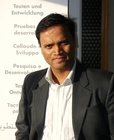Agenda
Please find below a copy of the conference agenda distributed at the event ...
mp14_conference_flyer_v4_nafems.pdf
Keynote Presentations
Multiphysics CAE: A Necessity for Durable and Reliable Vehicle Design
Prashant Khapane, JLR
The driving factors for durable and reliable vehicles are capacity(Inner noise) and demand (outer noise). One can further break it down into five noise factors, namely piece to piece, change over time, customer usage,external environment, and system interaction. Many of the tests used to design vehicles are single noise factor tests in order to either come up with the demand (fatigue/loads to design) or check the capacity. However from theattribute perspective at vehicle level it is important to consider multi-noisefactors while designing. It is no wonder that the system interaction plays themost important role and demands for a multi-physics CAE approach to solve theproblems. The presentation is about such scenarios and usage of CAE to solvethose.
Smart Manufacturing: CAE as a Service, On Demand, in the Cloud
Wolfgang Gentzsch, Uber Cloud
The benefits for small and medium size businesses (SMBs) of using High Performance Technical Computing (HPTC) within their design and development processes can be huge. However, the vast majority of SMBs perform virtual prototyping or large-scale data modeling still on their desktop computers. But because of the well-known limitations of these systems, many companies can't solve more sophisticated application problem, in shorter time. Therefore, most of these companies have a real need for additional HPTC.
In this presentation we will discuss two options for SMEs for acquiring additional HPTC power: buying an HPTC server or using cloud computing. Both options come with great benefits, but also with some challenges. We will present an overview of the status and trend of HPTC in the Cloud for digital manufacturing SMBs. And we will look at the reasons why we believe the acceptance of HPTC in the Cloud will strongly increase in the near future, especially for digital manufacturing. Finally, we will provide an outlook on how the UberCloud Experiments can accelerate the process of go-to-market and user acceptance of this new computing paradigm, and close with a few real-life hands-on case studies of CAE in the Cloud.
Low-Voltage Circuit Breaker Arc Interruption – A Multiphysics Modeling Challenge
Christian Rümpler, Eaton
Despite the increasing importance of power electronics in the area of high current switching, electro-mechanical switching devices like low-voltage circuit breakers are still the workhorses in industrial and residential power distribution systems. They provide excellent protect on towards overload and short circuit failure conditions, while power losses are small compared to semiconductor devices. Circuit breakers provide safe galvanic insulation - a must have in a majority of applications.
With increasing need for space savings and therefore increasing power density, the development of these devices needs to be supported by the best tools available to limit development risks. A major risk is associated with the interruption of high short circuit currents, causing large thermal and mechanical stresses.
Therefore a modeling approach was developed that covers the main physical processes during high current arc interruption in low-voltage circuit breakers. Multidisciplinary code-coupling is performed, combining the solution of fluid, electromagnetic and radiation equations. More complexityis added by considering the travel of the movable contact arm of the breaker inthis coupled approach.
Fluid, Solid and Radiation Modelling in Multiphysics Systems
Christopher Pain, Imperial College London
Here we present an outline of the work by Applied Modelling & Computation Group on development of radiation transport/neutronics, thermal hydraulics/multi-phase flows, and solids mechanics modelling. We present the coupling of these models together with their applications which now cover a range of industrially important, multi-physics phenomena. Current applications include: criticality in fissile solutions, nuclear reactor analysis and accident scenarios, ocean and atmospheric prediction, pollution dispersion through urban environments, single and multi-phase flows and coastal defense structures. To maximise computational efficiency and accuracy, we employ adaptive mesh resolution to perform some of the multi-scale modelling in which the finite element / control volume meshes are optimized to represent the physics. It is shown how errors in the overall solution can be calculated and how this approach can also be used to generate error measures to guide mesh adaptivity/numerical resolution.
As far as fluid-structure interaction modelling is concerned, the Finite Element Discrete Element Method (FEMDEM) is used for resolving the solids. FEM DEM is able to capture non-linear material behaviour and has multi-body and granular media capabilities so that sediment and scour can be modeled at the grain scale. The model Fluidity is used for the CFD. It is a multi-phase model based on arbitrary unstructured finite element meshes and has an anisotropic dynamic mesh adaptivity capability. This allows us to resolve highly complex geometries.
We outline future research directions in multi-physics modelling, an approach to adaptive multi-scale modelling and how this may be linked to predictive modelling including uncertainty quantification, dataas simulation and reduced order, or rapid, modelling.
Abstracts
A Coupled Euler Lagrangian Finite Element Approach to Flexible Pipe Seabed Interaction During Dropped Object Impact
Gill Alistair, Prospect
Simulation of a Folded Dielectric Elastomer Actuator
Elena Antonova, ANSYS, Inc.
A Comprehensive Integration Methodology Based on Multi-Physics Cosimulation. Case Study: Electro-Thermal Simulation of a Drilling System in a Harsh Environment
Michel Bareille, Altran Technologies
Fast, Exact Fully Coupled ODE Systems in Time Integration Schemes
Jaume Betran, Alstom Wind
Simulation of the Material Behaviour of Sheets During the Deep Drawing of Vehicles Bodies
Ouzine Boussaid, University of Annaba
Multiphysics Comes Alive: Capturing the Behavior of a Living Human Heart
Karl D'Souza, SIMULIA
Design of Experiments (DOE) Study of the Induction Hardening Process
James Farrar, Wilde Analysis Ltd
Numerical Simulation of Heat Exchanger using Two Stage FSI
Kathiresan Ganesan, FLSmidth
A Computational Method for Interface Problems in Multiphysics Applications
Volker Gravemeier, AdCo Engineering GmbH
One-Way FSI Analysis for High-Performance Blade Design with Open-Source Parallel FEM Software Front ISTR
Gaku Hashimoto, TheUniversity of Tokyo
Simulating Aggregate Drying using Coupled CFD and DEM Methods
Andrew Hobbs, Astec, Inc.
Evaluation of Fluid-Structure Interaction involving Abaqus and STAR-CCM+ for Industrial Use
Marc Hodapp, Festo AG& Co. KG
Conjugate Heat Transfer and Multi-Phase Analysis for Incompressible Flows
Nils Karajan, DYNAmore GmbH
Noise Prediction for Electric Motors by Coupling Electromagnetic and Vibroacoustic Simulation Tools
Gaurav Kumar, LMS, A Siemens Business
A Novel Co-Simulation Algorithm for Handling Field-Signal Interaction
Albert Kürkchübasche, SIMULIA
3D ANSYS Unmitigated Quench Simulation of Superconducting Coils
Antonio Lafuente, CCFE Fusion Association
Coupled Fluid-structure Interaction Simulations for Aero-Elastic Benchmark Cases
Bettina Landvogt, Fraunhofer SCAI
Innovative Developments in the Simulation of Ultraviolet Disinfection Systems
Simon Leefe, Wilde Analysis Ltd
Simulation of Wood Combustion in a Fixed Bed using CFD-DEM Coupling
Amir Houshang Mahmoudi, Université du Luxembourg
Acoustic Analysis of Fuel Tank Sloshing during Braking
Douglas Marriott, MSC Software
High Performance Computation Codes for Vibroacoustic Simulation in the Automotive Field
Guiseppe Miccoli, IMAMOTER Institute
Simulating Coupled Neutron-Fluid-Heat Transfer for the Study of Unintended Operating Scenarios in Pressure Water Reactors using an Immersed Body Modelling Technique
Moji Moatamedi, Imperial College London
Simulation of Vertical Axis Wind Turbines with Moving Blades
Henrik Nordborg, HSR University of Applied Sciences
Simplified Approach to Modelling Sonic Gas Dispersion for Offshore Well Test Operations
Naitik Patel, Expro North Sea Ltd.
Hysteretic Behaviour of Microbeam Structure in Electro-Elastic Analysis
Yichen Qian, ANSYS UKLtd.
Optimizing Fatigue Life using Automated Sequential Coupling in the Loop
Jon Quigley, Altair
Bi-Directionally Coupled CFD and Multi-Body Dynamics Solvers Applied to Tanker Truck Vehicle Dynamics
Jon Quigley, Altair
Multiphysics Simulations of Irradiation Damage Collision Cascades
Christopher Race, University of Manchester
Multi-Body Dynamics and Acoustic Simulation for Gear Application
Xavier Robin, Free Field Technologies
Electromagnetics Structural Coupling Simulation of Electric Motor
Mohamed Senousy, ANSYS,Inc.
Fluid-Structure Interaction with Controls for Wind Turbine Simulation using a Novel Co-Simulation Approach
Stefan Sicklinger, TechnischeUniversität München
Coupling of Structural and Multibody Mechanics in Switchgear Development
Christian Simonidis, ABB Corporate Research Germany
Multiphysics Software:Comparing Best-of-Class Approach Against All-in Strategy
Alfred Svobodnik, Konzept-X GmbH
Multi-Material Heat Transfer Analysis of an Engine Cylinder Head
Peter Tibaut, AVL- AST
Improve Pump Diaphragm Reliability using ANSYS Nonlinear FEA
Yong Wang, Parker Hannifin Corporation
Multiphysics Solutions in Offshore Engineering
John White, Prospect Flow Solutions Ltd.
Development of a Micro Gas Turbine with Ceramic Impeller: SCAI Tools for Stress and Vibration Analyses
Nadja Wirth, Fraunhofer SCAI
Multiphysics Simulation of the Aeroelasticity of Aircraft Wings
Chris Wolfe, ANSYS, Inc.
Piezoelectric–Structural–Fluids Analysis for an Ink-Jet Printer Nozzle
Chris Wolfe, ANSYS, Inc.
Keynote Speakers
Dr Prashant Khapane
Manager of Durability & Reliability CAE
Jaguar & Land Rover
Currently employed at Jaguar Land Rover as CAE manager.
Dr Khapane has more than a decade of experience in Multi-Body Simulation and Multi-Physics Simulation. Actively involved in vehicle dynamics and design. Having worked with major Aerospace, Automotive, and Railway industry players and also taken part in product development. He has traveled across the world and has cross cultural work experience. Long experience of working with various CAE tools and teaching MBS tools.
Wolfgang Gentzsch
Founder of Uber Cloud
Wolfgang Gentzsch is president and co-founder of the UberCloud Community and Market place for engineers and scientists to discover, try, and buy computing on demand, in the cloud. And he is the Chairman of the International ISC Cloud Conference series. Previously, he was Advisor to the EU projects EUDAT and DEISA, directed the German D-Grid Initiative, and was a member of the Board of Directors of the Open Grid Forum, and of the US President's Council of Advisors for Science and Technology, PCAST.
Before, Wolfgang was a professor of compute science and mathematics at several universities in the US and Germany, and held leading positions at the North Carolina Grid and Data Center in Durham, Sun Microsystems in California, the DLR German Aerospace Center in Gottingen, and the Max-Planck-Institute for Plasmaphysics in Munich. In the 90s, he founded HPC software companies Genias and Gridware. The latter, which has been acquired by Sun Microsystems in 2000, developed the well-known distributed cluster workload and management system Grid Engine.
 Dr Christian Rümpler
Dr Christian Rümpler
Corporate Research & Technology
Eaton
Christian Rümpler is with Eaton’s Corporate Research & Technology department in Moon Township, PA, USA. In his role as a Senior Specialist Engineer he is the technical lead for numerical modeling activities regarding arc interruption and switching. Key area of his research is a comprehensive modeling approach which is capable of covering the complex phenomena and processes that are happening during arc interruption and switching, with special focus on applicability in engineering applications. Before joining Eaton, he was with the Fraunhofer Institute for Scientific Computing and Algorithms (SCAI) in Sankt Augustin, Germany and the Moeller GmbH in Bonn, Germany. He received his Dr.-Ing. degree in Electrical Engineering from the Technical University Ilmenau, Germany.
 Professor Christopher Pain
Professor Christopher Pain
Professor Research Fellow Imperial College London
Prof.Christopher Pain is head of the Applied Computation and Modelling Group (AMCG) consisting of approximately 50 scientists and engineers at Imperial CollegeLondon. He was the original developer of the group’s main modelling framework Fluidity (http://fluidityproject.github.io), that he conceived in the first year of his PhD. Prof. Pain has attracted considerable research funding for the group’s modelling development and application from UK research councils, the EU and industry. Fluidity has been released as open source software and has a rapidly growing user/developer community across North America, Europe and Asia. In 2010 the AMCG won the Imperial College Research Excellence Award, an award from the College in recognition of world leading research
Prof. Christopher Pain’s main academic interests are in general Computational Fluid Dynamics (including multiphase flow, oceanography and geophysical fluid dynamics), nuclear engineering (neutron and photon transport, nuclear criticality, nuclear reactor dynamics, nuclear waste repositories), Optimisation, Data Assimilation, sensitivity analysis, reduced order modelling, Numerical Research, including parallel solution techniques, recurrent and feed- forward neural networks, a priorierror measures and mesh adaptivity, discretisation techniques, resolution of linear and non-linear equations, non-linear dynamics, numerical shape description and differential geometry. Inverse modelling has included anisotropic electrical inversion, 3D seismic inversion and inversion of transient 3-D coastal flow susing the adjoint method. Professor Pain has supervised 35 successful PhDs and published 150 journal papers.
